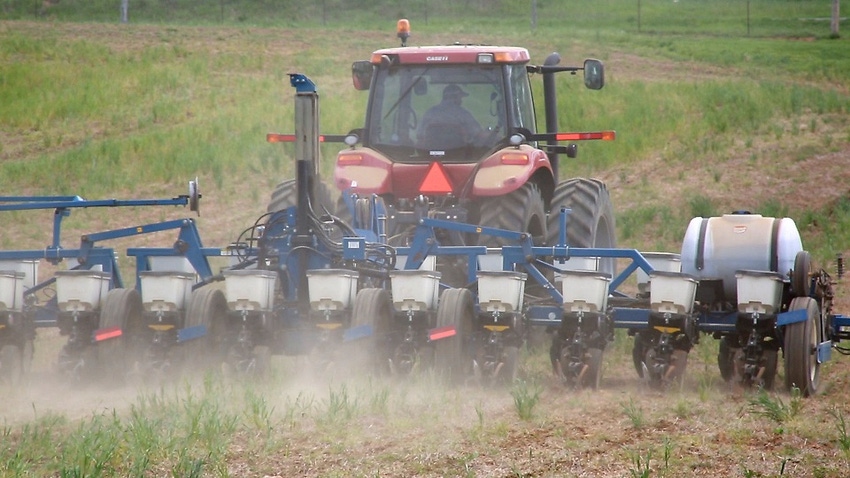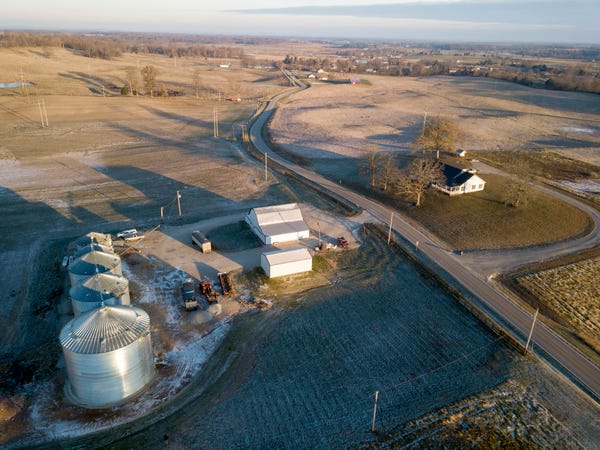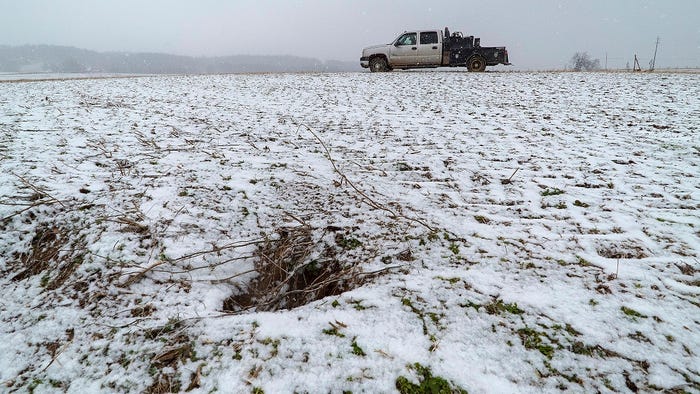February 25, 2019

Fred Sipes, Ekron, Kentucky will be recognized by the American Soybean Association during the Commodity Classic in Orlando, Fla. He is the South region winner of ASA’s Conservation Legacy Award.
The award recognizes outstanding environmental and conservation achievements of soybean producers.
A quick glance at a geologic map of Kentucky shows that the area around Ekron, where Fred Sipes farms, is classified as “intense karst.” For that matter, the majority of Meade County shares this classification, which describes a landscape that has developed over limestone. It supports beautiful scenery based on rolling hills, caves, and springs.
 But this is delicate scenery, and Sipes knows his actions influence water quality. “We have a large problem with sinkholes here,” he says. “We’re constantly working on buffer strips around these sinkholes, along with waterways to direct the flow of water from our fields.”
But this is delicate scenery, and Sipes knows his actions influence water quality. “We have a large problem with sinkholes here,” he says. “We’re constantly working on buffer strips around these sinkholes, along with waterways to direct the flow of water from our fields.”
The scientific term is “dissolution sinkholes,” and they develop slowly over time as the underlying limestone dissolves; once the void is large enough, the soil above collapses. The resulting sinkhole becomes a conduit, creating a direct path for surface water to enter the underground aquifer.
“It’s not unusual for us to go out in early spring and find a place in a field where a new sinkhole has developed,” Sipes says. “They increase the chances for nutrients and other contaminants to go directly into the groundwater system. We use buffer strips and grassed waterways to slow the water down and filter it before it enters the groundwater.”
Conservation minded
Sipes grew up in Meade County and developed an appreciation for the land as he worked for his family and other area farmers. But, when he went on his own following graduation from high school in 1994, his commitment to conservation went to a higher level, as he became a member of the board of supervisors for the Meade County Conservation District.
“I worked with the conservation district and the Natural Resources Conservation Service to incorporate conservation practices on my farm,” Sipes says. “I also stepped into a leadership role, encouraging other farmers in my area to do the same.”
Sipes began farming with a burley tobacco operation, but has since expanded to add soybeans, corn, wheat, hay, and cattle on 2,000 acres in the county. “I like diversity,” he says. “I figured out early that it was important to have more than one enterprise.”

As he added land to the operation, he looked for new ways to protect soil and water. In addition to grassed waterways, he incorporates buffers along the edges of many of his crop fields, where native plants slow surface water and filter it before it enters streams; the area also provides wildlife habitat.
In recent years, his involvement in the Conservation Stewardship Program (CSP) has led to a focus on nutrient management. “I try to maximize the effective use of nutrients and chemicals. And take additional steps to minimize losses into the environment,” Sipes says. “I don’t want them to get into the water supply. And they’re expensive, so I want them to stay on the farm and do their job.”
He uses a split application of nitrogen on the corn crop; 50% is applied within 30 days of planting, with the rest applied as sidedress. He also conducts plant tissue tests before the midseason nutrients are applied, allowing the crop to be spoon-fed with its specific need.
“Tissue sampling the last four or five years through the CSP program has really opened my eyes,” Sipes says. “It lets us see what we’re doing right, what we need to correct, and where we have problems.”
His approach to protecting the land also carries over to the cattle operation. Sipes has constructed a rotational grazing system, allowing him to manage cattle to minimize the impact they have on any one field. He also has constructed feeding pads, areas where a geotextile mat covered by rock protects areas of heavy use, such as around hay rings. The pads prevent cattle from tracking the soil and exposing it, leading to erosion.
Sipes also has constructed watering facilities in the grazing system, allowing him to fence cattle away from ponds and streams. “These practices allow me to tightly manage the herd and implement my nutrient management plan,” he says. “It also allows me to prevent a lot of potential negative effects on soil or water quality.”
Future focus
Sipes is focused on improving soil health, relying on no-till and incorporating more cover crops each year. “I intend to stick with a no-till operation,” he says. “We’re just about all no-till now, except for using a minimum-tillage tool to incorporate some wheat and cover crops in the fall. But I believe minimal disturbance of the soil is my best option.”

Cover crops have found a role in protecting his rolling land from erosion. “We started looking seriously at cover crops about five years ago,” he says “They definitely help prevent erosion, and we have seen yield increases following cover crops on some farms. So cover crops are going to be an integral tool in our toolbox.”
As his experience with conservation grows, Sipes has been called on through his volunteer work with many farm organizations to become a spokesperson for modern farming. One favorite topic is biodiesel.
“We raise soybeans, and soybeans make biodiesel,” he says. “We use it in our own vehicles as well as in tractors and combines. I’ve been fortunate enough to go to some vocational schools here in the community and promote biodiesel. It’s a chance to educate future auto mechanics and diesel mechanics on the value of biodiesel.”
He also devotes an increasing number of days to visiting legislators in Washington, D.C. “Many of them don’t have a farm background, but what they do in Washington can really affect us back here on the farm,” Sipes says. “I think it is important that the legislators have a chance to listen directly to a farmer.”
But most importantly, Sipes wants to continue his conservation efforts at home to prepare for the arrival of the next generation. He’s already thinking about how he can bring his sons into the operation — and that’s some forward thinking, since they were just born in 2018.

“My wife, Stacy, and I have twin boys, Joe and Sam,” Sipes says. "And we hope they are going to be a part of the farm operation one of these days. Conservation is a great tool, and we need to practice it to make the farm better when they come along.”
You May Also Like




